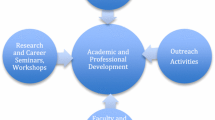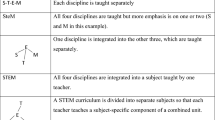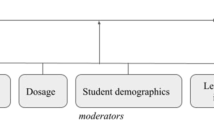Abstract
From 2006 to 2012, Florida Statute §1003.4156 required middle school students to complete electronic personal education planners (ePEPs) before promotion to ninth grade. The ePEP helped them identify programs of study and required high school coursework to accomplish their postsecondary education and career goals. During the same period Florida required completion of the ePEP, Florida’s Career and Professional Education Act stimulated a rapid increase in the number of statewide high school career academies. Students with interests in STEM careers created STEM-focused ePEPs and may have enrolled in STEM career academies, which offered a unique opportunity to improve their preparedness for the STEM workforce through the integration of rigorous academic and career and technical education courses. This study examined persistence of STEM-interested (i.e., those with expressed interest in STEM careers) and STEM-capable (i.e., those who completed at least Algebra 1 in eighth grade) students (n = 11,248), including those enrolled in STEM career academies, in rigorous mathematics and science course taking in Florida public high schools in comparison with the national cohort of STEM-interested students to measure the influence of K-12 STEM education efforts in Florida. With the exception of multi-race students, we found that Florida’s STEM-capable students had lower persistence in rigorous mathematics and science course taking than students in the national cohort from ninth to eleventh grade. We also found that participation in STEM career academies did not support persistence in rigorous mathematics and science courses, a prerequisite for success in postsecondary STEM education and careers.









Similar content being viewed by others
Notes
NAEP is a nationally representative and continuing assessment that is managed by the US Department of Education’s National Center for Education Statistics (NCES) (NCES 2016).
See Table AI.1 in the electronic supplementary material, which contains the demographic distribution of the HSLS and EDW STEM-capable cohorts.
See Table AI.2 in the electronic supplementary material, which contains a listing of the EDW raw data files.
See Tables AI.3-5 in the electronic supplementary material for baseline criteria of the EDW STEM-capable cohort in grades 9–11.
See Tables AI.6-11 in electronic supplementary material, which provide the 227 covariates selected in the HSLS dataset.
See Figures AI.1a-d in the electronic supplementary material, which contains the propensity score distributions before and after trimming.
See Tables AI.6-11 in electronic supplementary material, which describe the HSLS covariates balance before and after conditioning results.
See Tables AI.12-13 in electronic supplementary material, which describe the Florida EDW covariates balance before and after conditioning results.
See Table AI.14 in electronic supplementary material, which provide the frequencies of persistence for the Florida and HSLS STEM-capable students.
See Table AI.14 in electronic supplementary material, which provide the frequencies of persistence for the EDW and HSLS.
References
Adelman C (1999) Answers in the tool box. Academic intensity, attendance patterns, and bachelor’s degree attainment. National Institute on Postsecondary Education, Libraries, and Lifelong Learning. Washington. Retrieved from http://files.eric.ed.gov/fulltext/ED431363.pdf
Allison PD (1995) Survival analysis using SAS: a practical guide. SAS Institute, Cary, NC
Association for Career and Technical Education (2009) ACTE Issue brief: CTE’s role in science, technology, engineering & math. Association for Career and Technical Education, Alexandria. Retrieved from https://www.acteonline.org/WorkArea/DownloadAsset.aspx?id=2104
Austin PC (2011) An introduction to propensity score methods for reducing the effect of confounding in observational studies. Multivar Behav Res 46:399–424
Burkam DT, Lee VE (2003) Mathematics, foreign language, and science course-taking and the NELS:88 transcript data (NCES No. 2003-01). U.S. Department of Education, Washington
Carnevale AP, Smith N, Melton M (2011) STEM: science technology engineering mathematics. Georgetown University Center on Education and the Workforce, Washington. Retrieved from https://cew.georgetown.edu/report/stem/
Castellano M, Stone JR III, Stringfield S, Farley EN, Wayman JC (2004) The effect of CTE-enhanced whole-school reform on student course-taking and performance in english and science. National Research Center for Career and Technical Education, University of Minnesota, St. Paul. Retrieved from http://www.nrccte.org/resources/publications/effect-cte-enhanced-whole-school-reform-student-course-taking-and-performance
Chen J, Kaplan D (2015) Covariate balance in Bayesian propensity score approaches for observational studies. J Res Educ Eff 8(2):280–302
Chen H, Cohen P, Chen S (2010) How big is a big odds ratio? Interpreting the magnitudes of odds ratios in epidemiological studies. Commun Stat Simul Comput 39:860–864
Choy S (2001) Students whose parents did not go to college: Postsecondary access, persistence, and attainment (NCES No. 2001-126). National Center for Education Statistics, Washington
Committee on Prospering in the Global Economy of the 21st Century (U.S.), Committee on Science, Engineering, and Public Policy (U.S.) (2007) Rising above the gathering storm: Energizing and employing America for a brighter economic future. National Academies Press, Washington
Committee on Underrepresented Groups and the Expansion of the Science and Engineering Workforce (U.S.), Committee on Science, Engineering, and Public Policy (U.S.), National Research Council (U.S.), Policy and Global Affairs (2010) Expanding underrepresented minority participation: America’s science and technology talent at the crossroads. National Academies Press, Washington, DC
DuGoff EH, Schulser M, Stuart EA (2014) Generalizing observational study results: applying propensity score methods to complex surveys. Health Serv Res 49:284–303
FACTS.org (2010) Annual report 2009–2010. Florida Department of Education, Tallahassee. Retrieved from http://facts.org
FACTS.org (2012) Electronic personal education planner (ePEP). Florida Department of Education, Tallahassee. Retrieved from http://facts.org
Federman M (2007) State graduation requirements, high school course-taking, and choosing a technical college major. B E J Econ Anal Policy 7:4
Finkelstein N, Fong A, Tiffany-Morales J, Shields P, Huang M (2012) College bound in middle school & high school? How mathematics course sequences matter. Center for the Future of Teaching and Learning at WestEd, San Franciso. Retrieved from http://www.wested.org/resources/college-bound-in-middle-school-and-high-school-how-math-course-sequences-matter/
Fletcher E, Cox E (2012) Exploring the meaning African American students ascribe to their participation in high school career academies and the challenges they experience. High School J 96(1):4–19
Fletcher EC, Zirkle C (2009) The relationship of high school curriculum tracks to degree attainment and occupational earnings. Career Tech Educ Res 34(2):81–102
Florida Department of Education (2014) Florida career and professional education act (CAPE). Division of Career and Adult Education. Retrieved from http://www.fldoe.org/core/fileparse.php/7574/urlt/0101168-cape-act-techassist.pdf
Florida Department of Education (FLDOE) (2016) PK-20 education data warehouse. Retrieved from http://www.fldoe.org/accountability/data-sys/edw/
Florida Statute § 1003.4156 (2006). Retrieved from http://www.leg.state.fl.us/statutes/
Florida Virtual Campus (2012) Transition news for counselors and educators. Retrieved from http://www.fsw.edu/wp/echslee/wp-content/uploads/sites/10/2012/09/FACTS.pdf
Gordon HR (2014) The history and growth of career and technical education in America, 4th edn. Waveland Press, Long Grove, IL
Gottfried MA, Bozick R, Srinivasan SV (2014) Beyond academic math: the role of applied STEM course-taking in high school. Teach Coll Rec 116:070308
Hilton TL, Lee VE (1988) Student interest and persistence in science: changes in the educational pipeline in the last decade. J Higher Educ 59(5):510–526
Hong G (2004) Causal inference for multi-level observational data with application to kindergarten retention. ProQuest Dissertations and Theses, University of Michigan
Ingels SJ, Dalton B, Holder TE, Lauff E, Burns LJ (2009) The high school longitudinal study of 2009 (HSLS: 09): a first look at fall 2009 ninth-graders (NCES No. 2011-327). US Department of Education, Washington
Institute SAS (2010) SAS/STAT® users guide 9.3. SAS Institute Inc, Cary
Kemple JJ, Willner CJ (2008) Career academies: long-term impacts on labor market outcomes, educational attainment, and transitional adulthood. Manpower Demonstration Research Corporation, New York
Kersaint GK, Kromrey JD (2012) Effects of STEM aspirants’ high school experiences on STEM and ICT course-taking (Grant No. 1139510). National Science Foundation
Lanehart R, Rodriguez de Gil P, Kim ES, Bellara AP, Kromrey JD, Lee R (2012) Propensity score analysis and assessment of propensity score approaches using SAS procedures (Paper No. 314-2012). In: Proceedings from SAS global forum, Orlando, FL
Lanehart RE, Rodriguez de Gil P, Dixon MP, Kromrey JD, Kersaint G (2014) The impact of career academies on STEM course-taking: moving to the next level (Paper No. 310776). In: Proceedings from the 2014 joint statistical meetings, Boston, MA
Lichtenberger E, George-Jackson C (2013) Predicting high school students’ interest in majoring in a STEM field: insight into high school students’ postsecondary plans. J Career Tech Educ 28(1):19
Locke E (2009) Proposed model for a streamlined, cohesive, and optimized K-12 STEM curriculum with a focus on engineering. J Technol Stud 35(2):23–35. Retrieved from https://scholar.lib.vt.edu/ejournals/JOTS/v35/v35n2/pdf/locke.pdf
Maltese AV, Tai RH (2011) Pipeline persistence: examining the association of educational experiences with earned degrees in STEM among US students. Sci Educ 95(5):877–907
Maple SA, Stage FK (1991) Influences on the choice of math/science major by gender and ethnicity. Am Educ Res J 28(1):37–60
McCharen B, High K (2010) Career and technical programs of study and early indicators of retention in the College of Engineering. Association of Career and Technical Education Research, Ames. Retrieved from http://citeseerx.ist.psu.edu/viewdoc/download?doi=10.1.1.459.2123&rep=rep1&type=pdf
National Academy of Sciences, National Academy of Engineering, & Institute of Medicine (2007) Rising above the gathering storm: energizing and employing America for a brighter economic future. National Academies Press, Washington
National Association for State Directors of Career and Technical Education Consortium (2014) Career clusters. Retrieved from https://careertech.org/career-clusters
National Center for Education Statistics (2016) National assessment of educational progress (NAEP). Retrieved from http://nces.ed.gov/nationsreportcard/about/
National Economic Council (2011) A strategy for American innovation: Driving towards sustainable growth and quality jobs. Retrieved from http://www.whitehouse.gov/administration/eop/nec/StrategyforAmericanInnovation
National Mathematics Advisory Panel (2008) Foundations for success: the final report of the National Mathematics Advisory Panel. US Department of Education
National Research Council (2011) Successful k-12 STEM education: identifying effective approaches in science, technology, engineering, and mathematics. Committee on highly successful science programs for K-12 science education. Board on Science Education and Board on Testing and Assessment, Division of Behavioral and Social Sciences and Education. The National Academies Press, Washington. Retrieved from http://www.stemreports.com/wp-content/uploads/2011/06/NRC_STEM_2.pdf
National Science Board (2015) Revisiting the STEM workforce, a companion to science and engineering indicators 2014. National Science Foundation (NSB-2015-10), Arlington
Riegle-Crumb C, Moore C, Ramos-Wada A (2011) Who wants to have a career in science or math? Exploring adolescents’ future aspirations by gender and race/ethnicity. Sci Educ 95(3):458–476
Rodriguez de Gil P, Kromrey JD, Lanehart RE, Kim E-S, Montgomery J, Wang Y, Lee R, Cao C, Ashford S (2015a) An empirical comparison of multiple imputation approaches for treating missing data in observational studies. In: Proceedings of the SAS® Global Forum 2015 conference, paper 3316-2015. SAS Global Forum 2015, Dallas
Rodriguez de Gil P, Bellara AP, Lanehart RE, Lee RS, Kim E-S, Kromrey JS (2015b) How do propensity score methods measure up in the presence of measurement error? A Monte Carlo study. Multivar Behav Res 50:520–532
Rosenbaum PR, Rubin DB (1983) The central role of the propensity score in observational studies for causal effects. Biometrika 70(1):41–55
Sadler PM, Sonnert G, Hazari Z, Tai R (2012) Stability and volatility of STEM career interest in high school: a gender study. Sci Educ 96(3):411–427
Sadler PP, Sonnert G, Hazari Z, Tai R (2014) The role of advanced high school coursework in increasing STEM career interest. Sci Educ 23(1):1–13
Schneider B, Swanson CB, Riegle-Crumb C (1998) Opportunities for learning: course sequences and positional advantages. Soc Psychol Educ 2:25–53
Schwab K, Sala-i-Martín X (2015) The global competitiveness report 2015–2016. World Economic Forum, Geneva. Retrieved from http://www3.weforum.org/docs/gcr/2015-2016/Global_Competitiveness_Report_2015-2016.pdf
Seymour E, Hewitt NM, Friend CM (1997) Talking about leaving: why undergraduates leave the sciences, vol 12. Westview Press, Boulder
Shadish WR, Steiner PM (2010) A primer on propensity score analysis. Newborn Infant Nurs Rev 10:10–26
Singer JD, Willett JB (1993) It’s about time: using discrete-time survival analysis to study duration and the timing of events. J Educ Stat 18:155–195
Stern D, Raby M, Dayton C (1992) Career academies: partnerships for reconstructing American high schools. Jossey-Bass Education Series, San Francisco
Stone JR (2011) Delivering STEM education through career and technical education schools and programs [White paper]. Retrieved from http://sites.nationalacademies.org/cs/groups/dbassesite/documents/webpage/dbasse_072641.pdf
Stuart EA (2010) Matching methods for causal inference: a review and a look forward. Stat Sci 25:1–21
Tai RH, Qi Liu C, Maltese AV, Fan X (2006) Planning early for careers in science. Science 312(5777):1143–1144. doi:10.1126/science.1128690
Teitelbaum P (2003) The influence of high school graduation requirement policies in mathematics and science on student course-taking patterns and achievement. Educ Eval Policy Anal 25(1):31–57
Trusty J (2002) Effects of High school course-taking and other variables on choice of science and mathematics college majors. J Couns Dev 80:464–474
Trusty J, Niles S, Carney JV (2005) Education-career planning and middle school counselors. Prof Sch Couns 9(2):136–143
Tyson W, Lee R, Borman KM, Hanson MA (2007) Science, technology, engineering, and mathematics (STEM) pathways: high school science and mathematics coursework and postsecondary degree attainment. J Educ Stud Placed Risk 12:243–270
U.S. Department of Education. National Center for Education Statistics (1992) National educational longitudinal study, 1988: second follow-up (student data) [Computer file]. National Opinion Research Center [Producer], Chicago. Inter-University Consortium for Political and Social Research [Distributor], Ann Arbor
Ware NC, Lee VE (1988) Sex differences in choice of college science majors. Am Educ Res J 25(4):593–614
Acknowledgments
This material is based upon work supported by the National Science Foundation’s ITEST (Information Technology Experiences for Students and Teachers) program under Grant No. (1139510). Any opinions, findings, and conclusions or recommendations expressed in this material are those of the author(s) and do not necessarily reflect the views of the National Science Foundation.
Author information
Authors and Affiliations
Corresponding author
Electronic supplementary material
Below is the link to the electronic supplementary material.
Rights and permissions
About this article
Cite this article
Ashford, S.N., Lanehart, R.E., Kersaint, G.K. et al. STEM Pathways: Examining Persistence in Rigorous Math and Science Course Taking. J Sci Educ Technol 25, 961–975 (2016). https://doi.org/10.1007/s10956-016-9654-0
Published:
Issue Date:
DOI: https://doi.org/10.1007/s10956-016-9654-0




